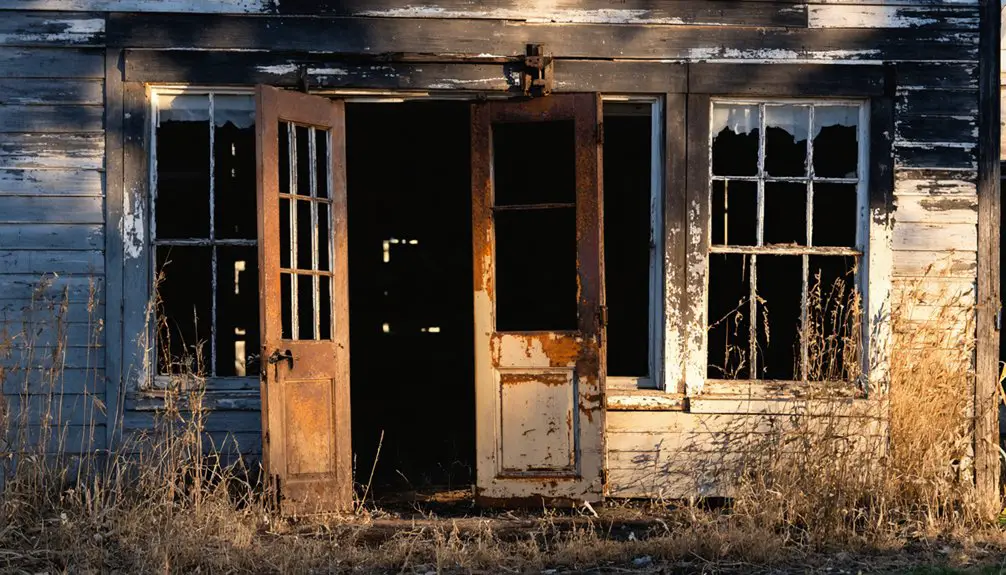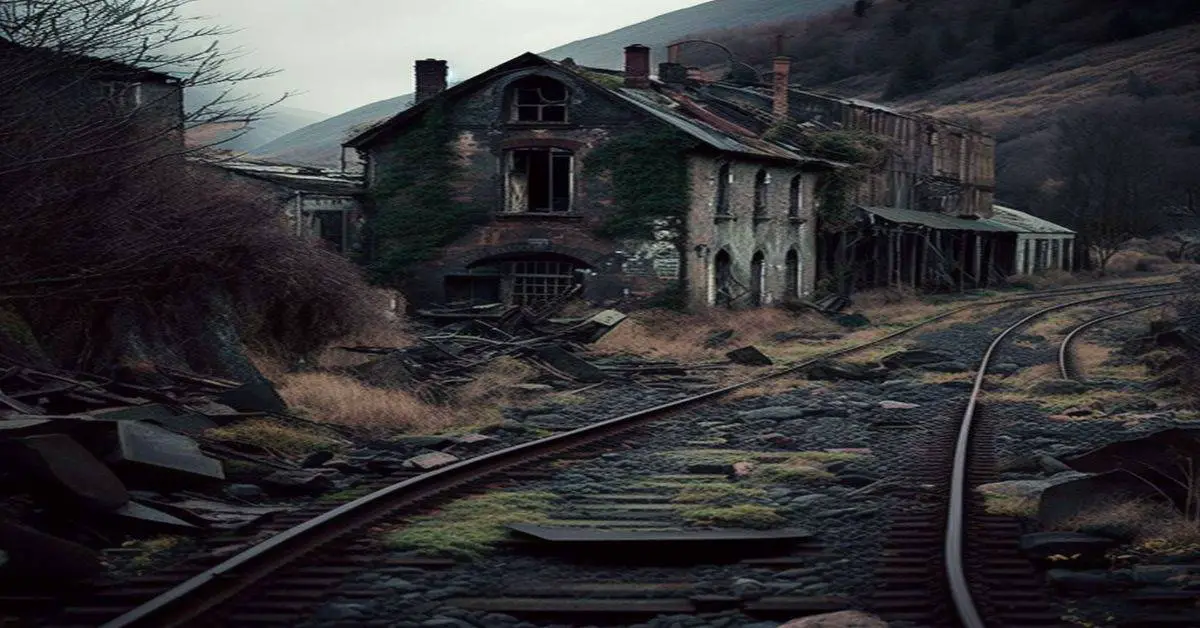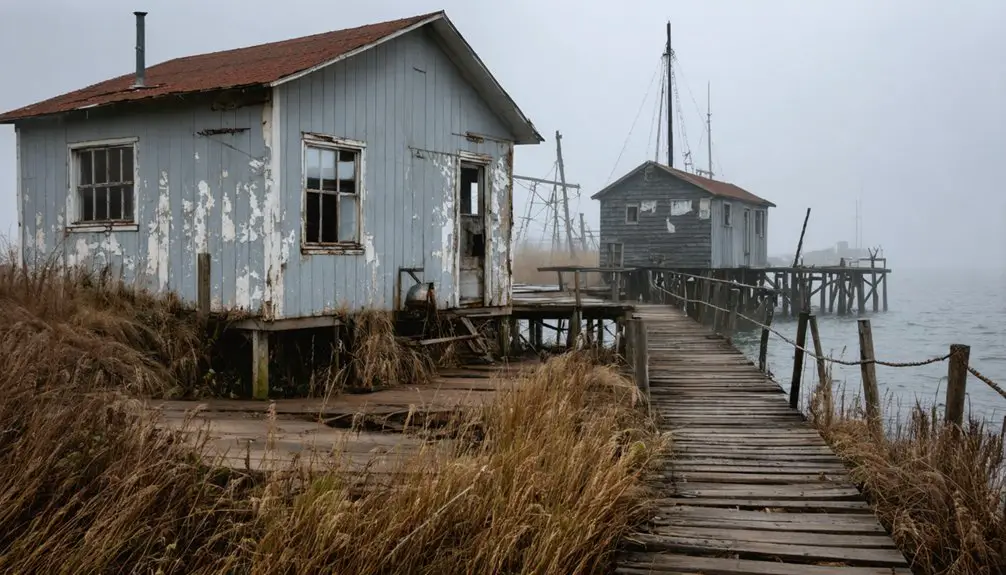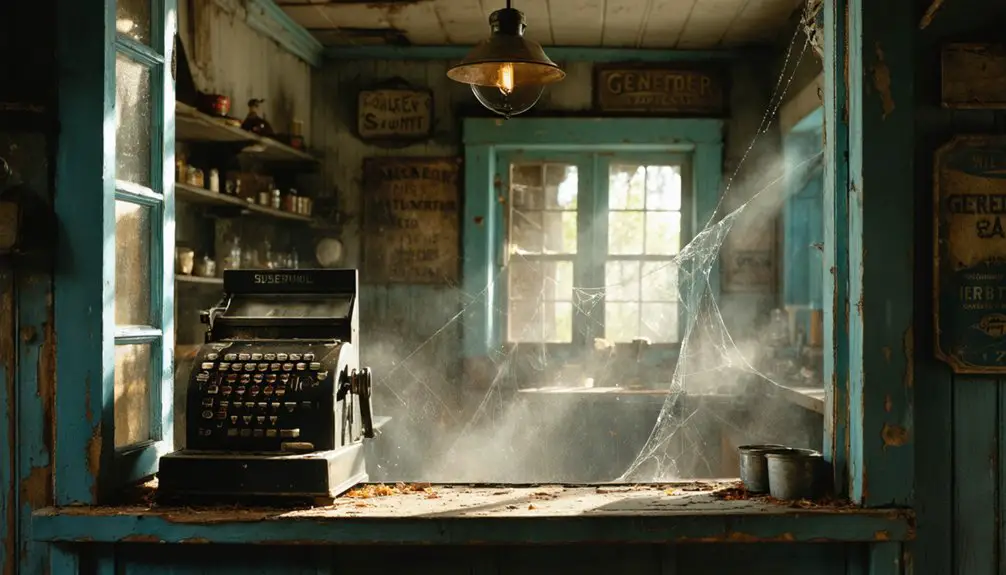You’ll find Coolidge’s ghost town remains in Price County, Wisconsin, where it flourished as a lumber settlement from 1886-1891. The town grew around W.H. Coolidge’s sawmill, which produced 80 million board feet of pine lumber and employed many of the 500 residents. Today, you can explore scattered stone piles, deteriorating structures, and a one-mile hiking trail leading to the old mill site. The fascinating story behind this abandoned railway town reveals much more.
Key Takeaways
- Founded in 1886 as a lumber settlement, Coolidge grew to 500 residents centered around W.H. Coolidge’s sawmill along the Wisconsin Central Railroad.
- The town’s sawmill produced 80 million board feet of pine lumber before closing in 1891, triggering the community’s initial decline.
- After the mill’s closure, businesses failed and residents left seeking employment, leading to plummeting property values and community abandonment.
- The post office’s closure marked a definitive end to the town’s active community life during its transition to ghost town status.
- Today, stone piles, deteriorating structures, and a one-mile hiking trail showcase the remnants of this former lumber boom town.
The Rise of a Lumber Town (1886-1891)
When the Wisconsin Central Railroad established a flag station in November 1886, the town of Coolidge emerged as a bustling lumber settlement roughly 8 miles north of Phillips.
You’d find the heart of the community centered around W.H. Coolidge’s saw and planing mill, which had been operating since 1884. Despite early settlement challenges, the town quickly grew to support a population of 500 residents. Much like laissez-faire economics that would later characterize President Coolidge’s era, the town operated with minimal government oversight.
Like many other timber towns across northern Wisconsin, the settlement followed the typical pattern of development sparked by railroad access. The mill’s lumber production techniques proved highly successful, generating an impressive output of over 80 million board feet of pine lumber during its seven-year run.
The settlement rapidly expanded to include two stores, a boarding house, and a post office to serve the growing workforce. Positioned strategically near Coolidge Lake and the railroad, the town exemplified the era’s dynamic relationship between rail transport and lumber manufacturing.
Life Along the Wisconsin Central Railroad
If you’d worked for the Wisconsin Central Railroad in Coolidge during the late 1880s, you’d have joined a close-knit community of railway workers who often passed their positions down through family lines, particularly the coveted role of section boss.
You’d have witnessed the daily rhythm of commerce as the flag station served both lumber operations and local merchants, with trains stopping only when signaled by station workers. After experiencing the Panic of 1873, many railway workers had developed a strong appreciation for steady employment and stable wages.
The railroad’s presence transformed Coolidge into a bustling hub where boarding houses and stores flourished alongside the tracks, serving both permanent residents and seasonal workers who shifted between summer mill work and winter logging. The town’s prosperity peaked when the W.H. Coolidge sawmill produced an impressive 80,000,000 board feet of pine until its closure in 1891.
Railway Workers’ Daily Life
Along the Wisconsin Central Railroad, railway workers endured grueling conditions while building and maintaining the essential transportation network through Coolidge.
You’d find workers rising at dawn, facing physically demanding work routines that lasted until sunset. During summer months, they’d focus on sawmill operations and track maintenance, while winter brought intensive logging work in the surrounding forests. Workers frequently went unpaid, leading to incidents like the Ashland War when stranded laborers demanded their wages.
You’d discover their living quarters in work camps near the tracks, where they shared basic accommodations and meals with fellow laborers. Under the watchful eye of woods boss Jack Felch and section boss William Ehmke, workers shifted between railroad and timber duties as seasons changed. The railroad’s reach expanded significantly when it connected to major cities like Chicago in 1886.
Your safety would’ve been at risk, as early railroad work relied heavily on manual tools with minimal protection against accidents and injuries.
Commerce Along the Rails
The Wisconsin Central Railroad‘s completion in 1877 transformed commerce across its 250-mile route from Menasha to Ashland, creating bustling economic corridors you’d scarcely recognize today.
Railroad expansion brought unprecedented growth to towns like Burlington, where daily commerce thrived with multiple passenger and freight trains. The introduction of the Burlington Passenger service in 1889 connected local residents directly to Chicago’s opportunities.
You’d have witnessed these key developments along the rail line:
- Fourteen passenger trains and six freight trains serving Burlington daily by 1886
- Rail depots becoming crucial economic hubs with turntables and engine houses
- Freight competition evolving from lumber to iron ore by the mid-1890s
- Paper and pulp mills generating significant cargo volume to Chicago
The railroad’s influence extended beyond mere transportation – it shaped the economic destiny of countless communities, turning remote outposts into thriving commercial centers connected to major markets. The railroad’s efficiency initiatives in the late 1980s helped win back market share lost to trucking, revitalizing rail commerce throughout Wisconsin.
W.H. Coolidge’s Industrial Legacy
President Calvin Coolidge’s industrial legacy profoundly shaped Wisconsin’s economic landscape through his pro-business policies and protectionist measures. During his presidency from 1923 to 1929, his economic nationalism and commitment to high tariffs directly impacted the region’s manufacturing communities.
You’ll find evidence of Coolidge policies throughout Wisconsin’s industrial corridor, where mills and factories flourished under his protective tariffs and hands-off regulatory approach. Local residents demonstrated their support by enhancing community facilities before his presidential visits. The president’s policies reflected the McKinley economic tradition of using tariffs to protect American workers and wages.
His strategic choice of Cedar Island Lodge for retreats highlighted his connection to Wisconsin’s industrial heartland. The nearby train depot improvements enhanced connectivity between local manufacturers and broader markets.
Under Coolidge’s administration, the Federal Trade Commission maintained a light regulatory touch, allowing regional industries to expand while the Fordney-McCumber Tariff sheltered them from foreign competition.
Daily Life in a Bustling Mill Community
During its peak in the late 1880s, Coolidge bustled with nearly 500 residents whose daily lives revolved around the town’s thriving sawmill operations.
You’d find a close-knit community where seasonal festivities and community gatherings often centered around the town’s key locations.
Life in Coolidge followed a distinct rhythm:
Small towns like Coolidge moved to nature’s tempo, each season bringing its own duties and daily patterns.
- Summer days were filled with the hum of the sawmill, processing millions of board feet of pine.
- Winter months saw workers shift to logging camps for timber harvesting.
- Daily errands took residents to the town’s two general stores and busy post office.
- Evenings brought workers together at the boarding house, sharing meals and stories.
The iconic lilac bush by the company vault served as a cherished landmark, blooming each spring as a symbol of the town’s energy.
The Path to Abandonment
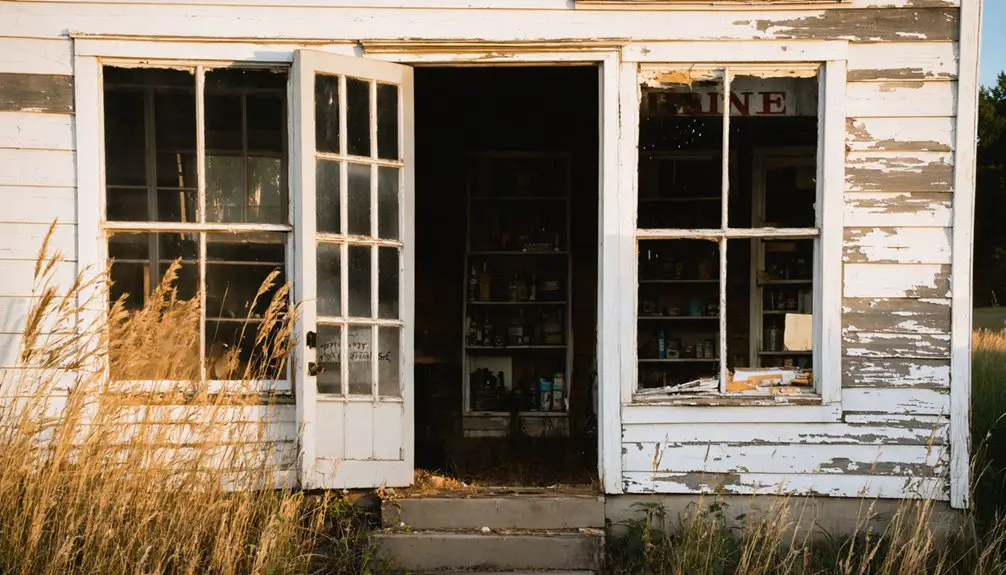
You’ll find that Coolidge’s decline began sharply in the early 1920s when plummeting silver prices forced the Elkhorn Mine to reduce operations and lay off workers.
The devastating dam failure on the Wise River destroyed critical transportation infrastructure, including the newly built narrow gauge railway, which effectively isolated the community during an already precarious economic period.
Mill Closure Impact Analysis
The closure of Coolidge’s cornerstone mill sent devastating ripples through the community’s economic and social fabric, marking the beginning of the town’s decline into abandonment.
You’ll find that Coolidge’s story mirrors many Wisconsin mill towns where economic decline struck swiftly and mercilessly. Despite initial community resilience, the shutdown created a cascade of impacts:
- Workers faced immediate unemployment without warning, leaving families without essential income.
- Local businesses dependent on mill workers’ patronage quickly folded.
- Property values plummeted as residents began moving away.
- Environmental contamination from mill operations limited redevelopment options.
The absence of alternative industries and the mill’s environmental legacy left Coolidge struggling to forge a new path forward, ultimately leading to its transformation into a ghost town.
Population Exodus Timeline
While Coolidge’s population peaked at roughly 500 residents during its lumber boom years, the town’s exodus began swiftly after the sawmill’s closure in 1891.
You’ll find that the population decline followed a predictable pattern: workers and their families left first, seeking employment elsewhere as economic factors made staying impossible.
The exodus continued steadily through the early 1900s, though you can trace remaining community lifelines through official maps into the 1940s.
The post office’s closure marked another significant turning point, as it served as one of the last essential connections to the outside world.
What Remains: Physical Traces Today
Standing as silent witnesses to Coolidge’s industrial past, scattered stone piles and deteriorating structures dot the remote Wisconsin landscape. Among these physical remnants, you’ll find the company’s vault pile in a clearing, serving as one of the most prominent historical markers of the town’s bygone era.
Today, you can explore what’s left of Coolidge by following a one-mile hiking trail that leads to:
- Decaying residential houses, some partially collapsed into nearby creeks
- The mill site, featuring standing chimneys that showcase its former industrial scale
- A secured mine entrance with visible water drainage
- The ruins of the 1880s saw and planing mill
Nature’s steady reclamation continues, with grass and trees covering the former mine dump, and lilac bushes blooming among the stone ruins.
Historical Significance in Price County
Deep within Price County’s rich logging heritage, Coolidge emerged as a pivotal settlement during Wisconsin’s lumber boom of the late 19th century.
You’ll find its story woven into the fabric of Price County’s transformation, when logging camps and sawmills dotted the pine-covered landscape.
As one of Fifield’s first settlements, Coolidge played an essential role in the region’s development. The town’s sawmill produced an impressive 80,000,000 board feet of pine, while its strategic position along the Wisconsin Central Railroad connected it to broader markets.
Though the physical traces have largely vanished, Coolidge’s cultural memory lives on through historical accounts that remind you of Price County’s evolution from resource-rich wilderness to settled territory.
It stands as a reflection of the remarkable but fleeting nature of Wisconsin’s logging era.
Frequently Asked Questions
Were There Any Major Fires or Disasters in Coolidge’s History?
You won’t find any documented fire incidents in Coolidge’s records, but a devastating 1927 Montana Power Company dam failure ranks as one of the town’s major historical disasters.
What Happened to the Residents After the Town Was Abandoned?
You’ll find relocation stories showing residents scattered to nearby Montana towns like Wise River and Butte, seeking mining work, while their community memories gradually faded as families adapted to new lives.
Are There Any Ghost Stories or Legends Associated With Coolidge?
Ever wonder about ghostly tales from abandoned towns? You won’t find documented ghost sightings or local folklore here – the town’s story is purely about industrial decline rather than supernatural events.
Can Visitors Legally Access and Explore the Ghost Town Site Today?
You can’t legally explore without verifying land ownership and obtaining proper permissions first. Access regulations are unclear, and site exploration requires checking local property records before visiting.
Were There Any Native American Settlements in the Area Before Coolidge?
Ever wonder about Wisconsin’s first inhabitants? You’ll find rich Native history in this area, where Potawatomi and Winnebago peoples thrived for centuries. Archaeological findings confirm their settlements near lakes and waterways.
References
- https://en.wikipedia.org/wiki/Coolidge
- https://southwestmt.com/ghosts/ghost-towns/coolidge/
- https://www.youtube.com/watch?v=xaO_0csHRJk
- https://www.youtube.com/watch?v=YHbTh5p0Vkk
- https://pbswisconsin.org/news-item/southern-wisconsins-ghost-towns-leave-behind-vital-stories/
- http://www.pricecountygenealogicalsociety.org/pdf/timeline1800-1894.pdf
- https://wi101.wisc.edu/the-lumber-industry-in-northern-wisconsin/
- https://foresthistoryassociationwi.com/wp-content/uploads/2021/04/November-Vol.-13-4.pdf
- https://mywisconsinwoods.org/2022/09/30/looking-back-at-the-history-of-wisconsin-forests/
- https://sites.rootsweb.com/~wiprice/coolidge.html
